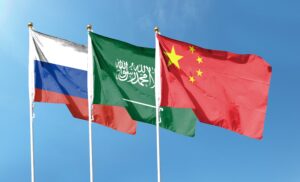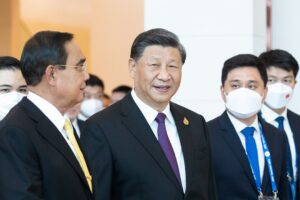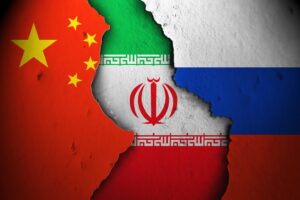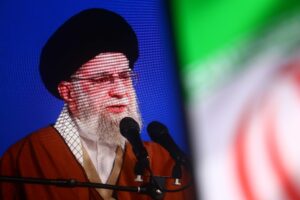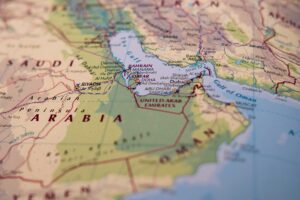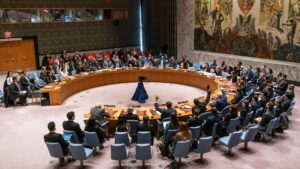
“The Making of Eurasia: Competition and cooperation Between China’s Belt and Road Initiative and Russia” by Moritz Pieper (I.B. Tauris: 2021).
Moritz Pieper’s ‘The Making of Eurasia: Competition and Cooperation Between China’s Belt and Road Initiative and Russia’ offers a brief but interesting account of contemporary Chinese and Russian strategy in the Eurasian heartland. Since the start of the millennium and particularly so over the last decade, the world has been focused more on different forms of internal Western neo-liberal political decay, from the election of Donald J. Trump as President of the United States to the pro-Brexit vote in 2016. As such, Pieper argues (p. 29-30), the People’s Republic of China and Russia have managed to successfully seize the opportunity to steadily mould the regional order of Eurasia in their respective visions; a process Pieper traces back to 1996 when Beijing and Moscow became united in their common quest to oppose post-Cold War U.S. unipolarity (p. 8-9; 22-23). Pieper attempts to analyse the construction of a new Eurasian regional order by investigating Sino-Russian relations in terms of both deepening cooperative interactions and, at times, competitive but friendly relations. In doing so, Pieper offers a fresh way of understanding the process of regional order construction in the globe’s most populous region through the analysis of actual diplomatic practice and accompanying discursive attempts that reinforce the creation of new orders (p. 8; 14; 19-21). Pieper, who is currently a lecturer of International Relations at Salford University, has authored numerous publications on Chinese and Russian geostrategy across the Middle-East, Central and Eastern Asia. In addition, Pieper has also held positions at different leading institutions specialising on Eurasian geopolitics across the globe, including a research fellowship at the China Foreign Affairs University, which places him among the growing list of Western scholars with actual insight of the region through personal experience there. In this contextually rich yet concise book, Pieper not only seeks to investigate the complex centrifugal relationship between the two regional giants China and Russia, but Pieper also rightly emphasizes that the central tenet of the book is to outline and address the different methods of political agency of, to use Rory Stewart’s phrase, China and Russia’s relations with ‘the in-between-states’ of the region (p.1).
At first, Pieper fleshes out the driving focus of his argument: China and its ‘Belt and Road Initiative’ (BRI) (Chapter 2; p. 7-22). Pieper seeks to accurately encapsulate the motivations of the BRI and the various consequential security questions arising from attempts to shape the region to China’s own interests. Here, readers may be at first surprised to discover that, from the internal Chinese political and philosophical perspective, the BRI project is not seen as a grand strategy in the traditional sense of grandiose ambitions of regional dominance through the subjugation of populations and/or military rule. In fact, Pieper cautions in later chapters the dangers of obfuscating the BRI with traditional conceptions of grand strategy as such views tend to represent China as a monolithic domestic political entity. Indeed, Pieper cements this position by postulating that, just like in liberal and transparent democratic countries, the leading Chinese authorities in Beijing, the civilian Chinese Communist Party’s (CCP), ambitions for the BRI differ from the Military Central Command, a divide he says is not exclusive to the civil-military debate as divisions over the BRI and its purpose also differ between different agencies and departments within China’s other civilian organs such as the Foreign Ministry (p. 25). That being said, Pieper admits the Chinese themselves envision the BRI as a way to best conceptualise contemporary ‘China’s growing presence in almost all policy domains in more than sixty countries around the world’ (p. 3). Indeed, China’s Foreign Minister himself, Wang Yi, has called the BRI the ‘most important public service provided by China to Asian and European continent [sic]’ (p. 4).
The internal Chinese political and philosophical perspective, the BRI project is not seen as a grand strategy in the traditional sense of grandiose ambitions of regional dominance.
Yet, for the CCP, they see the BRI as a successful modern-day reincarnation of the Middle Kingdom in which regional order surrounding China is slowly shaped in their vision and the surrounding regions/countries are essentially turned into ‘satellites’ of Beijing. Akin to the ideas of ‘American exceptionalism’ when discussing America’s role in foreign policy, China’s shaping of the BRI as a mutually beneficial as well as a mutually profitable endeavor is very much reminiscent of the Tianxia or ‘all under Heaven’ concept of China’s role in global affairs throughout ancient times. Similar to how proponents of ‘American exceptionalism’ posit the U.S. as being a unique actor in global affairs which seeks to be a beacon of hope, or what Gordon S. Wood labelled an ‘empire of Liberty’, through some self-believed divine anointment, the major concept within tianxia is the belief of Chinese politicians and diplomats. Furthermore, much like how ‘American exceptionalism’ is labelled unique because of its perception as a beacon for spreading specific norms and values such as freedom and liberty which came to define the political order of ‘the West’. This, of course, ran in tandem with America’s growing military strength over the last two-hundred years which not only defended these values and norms against various ‘foreign’ threats (Nazism, Communism, etc., etc). Perhaps the single best encapsulation of this was President Franklin D. Roosevelt’s speech to the Congress and population of the U.S. advocating for the need to aid nations fighting fascism in what he labelled as supporting and funding the ‘Arsenal of Democracy’. In practice, with respect to China, Tianxia, followed a similar pattern through what was called the ‘Tributary System’ throughout the 12th-19th centuries (John Fairbank and Ssu-yu Teng, 1941; Ji-Young Lee, 2017; Asim Dogan, 2021) but with roots traceable as far back as 2852-20170BC (Hucker, 1995:22 in Dogan, 2021: 11). Similarly, Tianxia is a philosophical conception of self-identification rooted in Confucian thought that prescribes not only a divine right for China to rule its neighbourhood but almost as a divinely appointed duty or mandate to shape its regional order, in what has become popularly termed as a ‘mandate of Heaven’. Although the ‘Tributary System’ was not formally instituted in China until the early-Ming Dynasty, throughout the centuries Tianxia was never exclusionary in its embrace of ‘outsiders’, be that ethnic minorities or religious ‘enemies’, but rather open to all as long as such external actors whether the Japanese, Korean, Thai, Vietnamees accepted the supremacy of the Chinese emperor. This Chinese worldview can very much be seen in the relationship between China and other smaller powers in the region and not least can also be immediately noticed in the Mandarin word for China, Zhong Guo, which directly still translates into ‘Middle Kingdom’.
The BRI’s infrastructure and economic projects are seen as China’s attempts to restore the fairness of a region usually dominated by ‘outsiders’ in addition to China’s resumption of Great Power status once again.
Nonetheless, Pieper further concedes that this view of China’s BRI has been the subject of increasing academic and political accusations of modern imperialist gesturing akin to the ancient Chinese Middle Kingdom’s efforts of regional supremacy (p. 2). According to Pieper, ‘[W]here the BRI differs’ from those of China’s rulers’ past ‘is in its scale and the extent to which a concerted government effort affects not only the realization of the planned projects, but also the entire Chinese public diplomacy’ (p. 13). By funding and creating large-scale infrastructure projects without political conditions for largely authoritarian Eurasian countries, China has managed to insert itself as the region’s leader and guide by offering an alternative source of funding separate from Western-dominated institutions such as the IMF or World Bank. As such, the success of the BRI rests on Beijing’s ability to promote BRI projects as a form of mutual ‘win-win cooperation’. In fact, the BRI’s infrastructure and economic projects are seen as China’s attempts to restore the fairness of a region usually dominated by ‘outsiders’ in addition to China’s resumption of Great Power status once again (p. 23). Such prescriptions by Chinese authorities run in tandem with their larger regional aim of removing U.S. influence in the region with the ultimate aim of completely dislodging America’s presence there in favour of their own.
The reality is, however, as Pieper puts it, the debt traps arising from the BRI’s infrastructure loan programmes across Eurasia in countries like Pakistan, Sri Lanka, Uzbekistan, and Kazakhstan, or in the so-called ‘in-between’ states, which actually see a degradation of their own sovereignty in the same vein in which China is accusing the U.S. of being guilty for throughout much of the Cold War (p. 9-11). In this new ‘China-centered model’ of regional order, Pieper foreshadows that Central Asia will become increasingly more dependent on China (p. 22-23). Finally, in this chapter, Pieper separates himself from the mountainous growing literature on the BRI and contemporary Chinese grand strategy by offering an attempt to first categorise and then separate the underlying (political and economic) motivations for the BRI from the postulated ‘Five Openings’ that are often purported as the motivation behind the project by Beijing officials. Although Pieper does well here to highlight the geopolitical undercurrents of the BRI, paying particular attention to the geographic and political importance of Xinjiang in China’s efforts to expand westwards through the BRI. Nevertheless, throughout the chapter, Pieper refuses to accept that while the BRI was originally conceived of as an economic plan by President Xi Jinping in 2013 as a way to cope with Beijing’s slowing economic progress, the fundamental premise of the project remains distinctively geostrategic in nature (p. 13-15; 19-21).
Moving on, in the third chapter, Pieper then tackles Russian attempts to create a regional order but through the analytical dynamic of assessing Sino-Russian relations in Eurasia in the face of China’s BRI, as opposed to a stand-alone chapter dedicated to Russian ‘grand strategy’ and its aims, objectives, issues and potential future endeavours in the same manner he treated China’s BRI in Chapter 2 (p. 25-41). Nonetheless, Pieper immediately underlines the importance of this novel approach for understanding contemporary Eurasian geopolitics by stating that ‘as a region which Russia regards as its “sphere of influence”’ (p. 25). It is interesting to witness, in the wake of Western decline in the region, how Russian policymakers do not automatically presume all Chinese efforts of regional order as being in contention with Moscow’s own objectives (p. 25-26). Showing a stronger geopolitical undertone in this chapter, Pieper builds on Sir Halford J. Mackinder’s ‘Eurasian heartland’ theory originally published in The Geographical Pivot of History (1904) and later further developed in Democratic Ideals and Reality (1966) as well as Zbigniew Brzezinski’s The Grand Chessboard (1997).
Pieper is implicitly arguing that one of the major geopolitical contests of the coming age is between Russia and China.
Not only is this because Mackinder’s original conception of the ‘Eurasian heartland’ defined as the large landmass stretching from west of the river Volga to east of the Yangtze river matches that of what Pieper defines as Eurasia based on sociological, historical and political grounds. Like Mackinder, Pieper is implicitly arguing that one of the major geopolitical contests of the coming age is between Russia and China. Pieper like Mackinder, is also pessimistic about the potential chances of a relatively stable Eurasian region due to the inability of either power to attain full hegemony, or what Pieper would perhaps argue as supreme authority to shape regional order, yet each power’s reluctance to relinquish those ambitions which inevitably produce a self-perpetuating cycle of tension and uncertainty. Running even deeper than this, while both Pieper and Mackinder understand the elusiveness of such irony, they do not suggest that the door on attaint regional hegemony or ability to shape regional order is therefore permanently closed as for one, they both place a premium on the advancement of infrastructure in closing that gap. For instance, although most of Mackinder’s writings focus on the creation of railroads connecting mainland Europe with Central Asia and what this would mean for a resurgent imperial Germany, both Pieper and Mackinder argue that it would most likely be a Chinese-driven presence that will come to dominate Eurasia. In this sense, China’s BRI, Pieper would argue, is the final (attempted) realisation of Mackinder’s theory. Indeed, it is evident in Pieper’s book that he draws on other main arguments of Mackinder such as his focus on Russian dominance in the region emanating from a purely security perspective (p. 25-26; 30-32). While Mackinder acknowledged the strength of Russia, the largest country in the world, he maintained a view of Tsarist Russia as a sociologically backward and politically destitute power unable to appropriately and successfully project its power across the region despite being the largest country in the world. Pieper, on the other hand, firstly argues that it is actually Russia’s own historical connection to the region’s other countries through language, culture and religion that has contributed to the strengthening of Russia’s ability to shape the region in its own vision.

Sino-Russian relations today need to be seen against ‘the background of a web of overlapping institution memberships’, the make-up and function of the two respective institutions used by Moscow and Beijing to consolidate and multiply their influence.
With that in mind, Pieper is not suggesting that Sino-Russian relations are completely smooth or entirely friendly. In fact, at best, Pieper describes the post-Soviet relationship between China and Russia as ambivalent and at times, tense (p. 29). Nowhere is this best evident than in Vladimir Putin’s and Xi Jinping’s use of different multilateral regional institutions in striving to attain their own respective national interests in the effort to shape the region to their demands and needs. As a result, this has contributed to an increased revitalised narrative of irreconcilability between the two great powers’ aims, reminiscent of the Sino-Soviet split throughout 1956-1966 (p. 28-30). For example, Pieper outlines that, concerning questions of regional security policy, Russia’s preferred institution is the Collective Security treaty Organization (CSTO) and, more recently, the Eurasian Economic Union (EAEU) as it best serves to strengthen Moscow’s regional aims (p. 29-30). Meanwhile, China’s preferred institution and forum for dealing with regional issues remains the Shanghai Cooperation Organization (SCO). Both powers are held largely responsible for spearheading not just the founding of these organizations but also in moulding and nurturing these organizations in the shape we have come to see them today. Indeed, Pieper makes the point that Sino-Russian relations today need to be seen against ‘the background of a web of overlapping institution memberships’, the institutional make-up and function of the two respective institutions used by Moscow and Beijing to consolidate and multiply their regional influence goes to the heart of Pieper’s overarching argument (p. 29).
For Russia, the CSTO remains a vital component of its espoused national prestige in terms of both domestic and international audiences, and particularly so after the fall of the Soviet Union (USSR). Created in 1992, the CSTO is often hailed as a mirror organisation of the North Atlantic Treaty Organization (NATO). Just like its Western counterpart, the CSTO was originally conceived of as a collective military alliance but steadily evolved into a politico-military institution that goes beyond its originally intended mission when the treaty was first signed. And, just like NATO, the CSTO claims to guarantee that an attack against one of its members is considered an attack against all (p. 29-30). Drawing on Roy Allison’s work on post-Cold War Eurasian geopolitics, Pieper points out that the CSTO’s focus on Central Asia—particularly the former Soviet States of Central Asia—as its ‘zones of responsibility’ (p. 30), accurately depicts Russia’s commitment to the idea that the region is part of its sphere of influence and therefore is an exclusive zone where all defence and security policies are handled by Moscow.
Although Russia has largely failed in its efforts to turn the CSTO into a strictly ‘anti-NATO’ instrument as it had previously done with the Warsaw Pact, the unstable nature of most Central Asian regimes means that their governments and thus their countries remain inextricably interlinked and dependent to Russia in instances of military, security, and defence issues. This is best evidenced by the ongoing dependency of these regimes on Moscow’s continued supply of weapons, intelligence-sharing, border security cooperation and even joint-military exercises (p. 30). As a result, Pieper contends that any attempts by the Chinese to foster any large-scale regional agreements with a distinctively military nature are not only unwelcome by Moscow but are also seen to be potentially threatening. This is the driving factor behind Moscow’s dissatisfaction over China’s proposed creation of the counter-terrorist Quadrilateral Cooperation and Coordination Mechanism (QCCM) platform with Afghanistan, Pakistan and Tajikistan. (p. 30). In addition to Russian prestige, despite the CSTO being a multi-layered and multifaceted institution, it is also a forum with which the other nations of the region who share significant social, political, cultural, and even linguistic ties with Russia allows Moscow to exercise a level of overlordship similar to its pervasive and extensive control of these countries under the USSR. Therefore, there remains a ‘certain Soviet mentality’ about the CSTO, which has not only enabled Russia to exercise a similar level of security guarantee to the region as it had during the Cold War (thereby priming Moscow as the region’s guarantor of peace and security), but implicitly the existence of the CSTO means that the ‘in-between’ places have once again accepted Russia’s dominance.
Contrasted to China’s use of the SCO in shaping the region, Pieper paints a different picture. Here, the main point of contention in the Sino-Russian relationship has been the inability for China to find a particular policy domain for which it can 1) purport to have exclusive leadership over and 2) is acceptable to Russia (p. 31). This has begun to change at the turn of the twenty-first century and further solidified with the launching of the BRI. Originally founded as a counter-terrorist organization, the SCO itself was launched with the aim of curbing security threats and bolstering the general position of China in the region. Like the CSTO, the SCO has a specific geographic focus that serves a particular political objective for the CCP. At first, the push for the CCP to expand and deepen the SCO rested on Chinese fears of the ‘three evils’ -terrorism, separatism and fundamentalism – in the wake of the Taliban takeover of Afghanistan in 1996 and growing Chinese fears over what consequences this would pose for Xinjiang (p. 30). Therefore, as in the case of Russian and its preferred medium of going through the CSTO, China’s original plan for establishing the SCO was premised on hard security concerns (p. 30-32). With the launching of the BRI, however, the CCP has increasingly instrumentalised the SCO to support the project. As such, just as the CSTO serves to solidify Russian security and defence activities in an effort to strengthen (or some would argue reclaim) its Soviet past, China too seeks to legitimise its economic regional activities by way of ‘multilateral embedding’ (p. 31). As such, by mainly sticking to ‘low-politics’, Pieper argues that China is inadvertently accepting the regional political status-quo of Russian supremacy (p. 31). For the most part, the general sense for Pieper is that he paints Russian strategy in Eurasia as a defensive policy while China’s as an attempt to expand, a theme that runs throughout the book (p. 37; 43-48).

Pieper offers interesting and in-depth analysis of the different strategies of entanglement promoted by China through the SCO and Russia through the CSTO.
The remainder of the book serves to then give treatment to a selected list of the ‘in-between states’ of Uzbekistan, Kazakhstan and Mongolia, adding unequal weight to the importance of Kazakhstan to the others which Pieper labels as the ‘linchpin of Eurasia (p. 43), as well as some selective engagement with other regional countries such as Kyrgyzstan and Tajikistan. For the most part, Pieper offers interesting and in-depth analysis of the different strategies of entanglement promoted by China through the SCO and Russia through the CSTO. The analysis is rich in context and surprisingly contains an extensive literature review of recent historical and contemporary scholarship on the matter. Pieper covers subjects from the BRI’s and Russia’s economic policy, security engagements, infrastructure diplomacy and even briefly mentions how these countries adapted to the Coronavirus pandemic in furthering their attempts to create and sustain a regional order (p. 98; 143). Yet, for all the emphasis placed at the beginning of the book for the importance of assessing how China and Russia deal with the ‘in-between states’ of the region, Pieper does not really offer much of a new contextual or theoretical understanding of these places and how they fit the larger Eurasian chessboard. Neither does Pieper actually offer much analysis of ongoing U.S. involvement in the region, for which Pieper’s lack of grappling with this angle would suggest to readers that he may be insinuating that Western influence in the region is of little to no significance, which would be problematic in and of itself.
Moreover, for a book to be published in 2021 and still have considered the effects of the Coronavirus pandemic, it is a shame that other more recent events have been taken into account such as the recent U.S. withdrawal of Afghanistan. Of course, no book, no matter its length or voluminous editions, can account for everything, yet this runs in the face of one of the other major problems of the book which has been to largely discount the Sino-Russian competition in the Middle-East—an area that at least for Russia is considered as integral to Eurasia. This can not only be evidenced in Russia’s recent overseas military interventions in places like Syria and Libya, but also in the subtle undertones of other Russian endeavours, not least in the flag and symbol of EAEU which includes in it the Arab Gulf region as well as Russia’s push to include Iran, Armenia and others into the SCO.
All in all, Pieper’s greatest offering in the book is the way in which he was able to dissect and decompartmentalise the different regional intentions and ambitions of China and Russia respectively, and his ability to distinguish their different regional strategies in a manner that challenges rather then enforces simplistic notions of the Sino-Russian relationship being a smooth and easy one. What Pieper’s book excels in contextual richness it lacks in contextual breadth through limited case-studies and its focus primarily on security and economic factors while remaining largely silent on other non-tangible factors such as cultural, political and linguistic regional endeavours. This is the case, despite Pieper being adamant that among one of the reasons that China has not been able to dislodge Russia from its position as the region’s prime security guarantee emanates to a large extent from the shared cultural and social values between Moscow and the rest of the former Soviet Central Asian states.
Dogan, Asim. Hegemony with Chinese Characteristics: From the Tributary System to the Belt and Road Initiative. London: Routledge, 2021.
Fairbank, John and S. Teng. “On the Chi’ing Tributary System”. Harvard Journal of Asiatic Studies. 6. 2 (1941): 135-246.
Lee, Ji-Young. China’s Hegemony: Four Hundred Years of East Asian Domination. New York: Columbia University Press, 2017.



